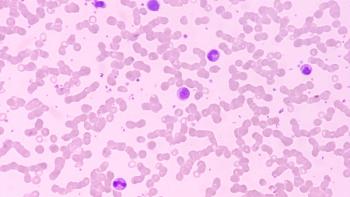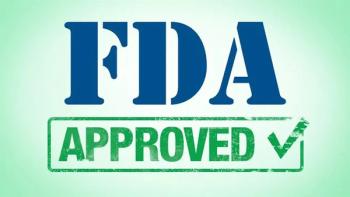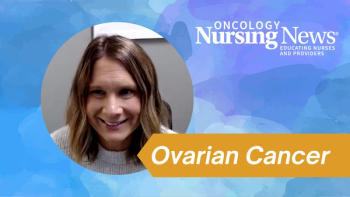
Best Practices in Managing Talquetamab-Associated AEs in Myeloma
A nurse practitioner gives her advice for managing adverse events during treatment with talquetamab for multiple myeloma.
Oncology nurses and advanced practice providers (APPs) administering treatment with talquetamab (Talvey) for multiple myeloma should educate patients early on to look out for adverse events (AEs) such as dysgeusia, nail ridging, and dry mouth, according to an expert.
Samantha Shenoy, MSN, NP, a nurse practitioner at the University of California San Francisco, has been seeing patients treated with talquetamab for years on the phase 1b TRIMM-2 (NCT04108195) and MonumenTAL-2 (NCT05050097) trials.
From her experience with the more unusual AEs that accompany talquetamab treatment, she has compiled a handout that she shares with her patients and peers on best practice for managing such events.
When confronted with these AEs, she worked with APPs at other institutions and professionals from different specialties at her own institution for clinical advice. Shenoy mentioned that she also learned some techniques, like protecting the hands with finger cots, from her patients.
Transcript
We had the TRIMM-2 trial and MonumenTAL-2 trial at UCSF. Both of these trials were looking at combinations of medications with talquetamab. Our first patient started about 4 years ago, and they were having the taste changes, so the dysgeusia, the dry mouth, the skin peeling.
Really, I’d never seen anything like that before in my clinic. I reached out to some
Then I reached out to a nutritionist and started having them see my patients. And they gave me many great tips, 1 of them being [that] there’s this fat, acid, salt, sweet formula they use for people with taste changes. So if something tastes bitter, they recommend using these sorts of interventions, if it tastes too sweet, too bland, et cetera.
Also, I started to collaborate a lot with [the dermatology department]. Sometimes I had cases that were pretty easy to treat (rashes, et cetera), but sometimes there were cases that I needed more guidance [on], so I would consult with dermatology. Basically, [I learned from] collaborating with other APPs, speaking to nutrition and dermatology [experts], and also learning from patients.
I had a patient who walked in—and with talquetamab, you can have nail ridging, and your nails can start to fall off at different points in treatment—and showed me, “Look, I bought these finger cots.” They’re just single finger gloves. And so I learned things from patients.
Basically, I took everything I learned and…put in it all together into a handout, which I’ve now addended probably 20 times over the last 4 years. I made a handout that I have now circulated to staff and patients.
I think it’s really important, with a drug like talquetamab, specifically, that has these unique adverse events, to have a handout and give it to patients ahead of time, so that patients are empowered to try some of the things and have some of the materials available before they’ve even started.
For example, we know that talquetamab causes dry mouth. So before they’ve even started, I’ve had patients who [will] go and get the dry mouth lozenges, or get the creams that are necessary, different emollients, for example, just to have ready to go so that they’re able to address some of the adverse events that they’re going to most likely experience.
Talquetamab targets GPRC5D, and because of the location of that target, all of these things are very unique. So in terms of myeloma drugs, there’s no drug that’s been FDA approved in myeloma that has these side effects. In terms of the dysgeusia, because of the taste alteration, it’s really important for nurses and APPs to check in with patients about their weight, because weight loss can be an issue on this drug if you don’t stay ahead of it.
It’s also really important to check in with them about different techniques they’re using for dry mouth, because if your mouth is dry, you’re not going to be able to taste very well. In addition to having a really dry mouth, you really want to make sure that patients have really good oral care: brushing their teeth twice a day, having regular dental checkups, just keeping everything really clean because you don’t have that normal saliva that helps wash the bacteria away. So good oral care is really important. The skin toxicities are pretty manageable, but I still think it’s really important to stay on top of that and talk to patients about good emollients, topical steroids, if needed, for the nail changes. It’s more of an aesthetic issue, less so a pain issue.
…APPs and nurses can also talk to patients about things they can do, like keeping their nails short and filed, and avoiding wearing tight shoes or anything that puts a lot of pressure on the nails, keeping everything really well hydrated. For APPs and nurses, I think it’s really important to just remind patients that this will get better, because when patients are first starting this drug, it can be challenging, and I think it’s really important to remind them that it will get better. It might take some time, but it will get better, and hey, here’s all these things we can do.
That’s what I think is nice about the handout. It’s a 4-page handout. I couldn’t help it. I didn’t want to cut it down, but I wanted to put everything I learned into 1 handout. And so I tell my patients just try 2 things, maybe, today. Just give it a shot. If it doesn’t work, fine, but it’s important to talk to these [issues] when patients come into clinic, reviewing some of these AE management techniques, and reminding them it will get better.
[It is also important] for nurses in the clinic, if they’re noticing weight loss, and maybe it hasn’t been addressed, to alert the provider about that or any other concerns that they may have. Nurses and APPs play a huge role in helping with patients who are getting talquetamab and trying to manage and navigate all those adverse events.
This transcript has been edited for clarity and conciseness.
Newsletter
Knowledge is power. Don’t miss the most recent breakthroughs in cancer care.

















































































